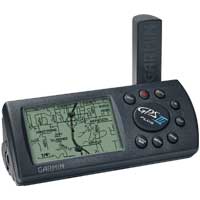
| What is GPS? | How Does it Work? | Is It Accurate? | What Are GPS Signals? | What Are the Sources of Signal Error? | What Are the Uses of GPS? | What is the Future of GPS? | Bibliography |
GPS satellites send signal information to earth by rotating in a specific orbit twice a day. On earth, GPS receivers can be found to receive the information from the satellites and calculate the userís exact location. The GPS receiver does this by first finding the difference between the time the signal was sent by the satellite and the time the signal was received on earth, the difference tells the GPS receiver the distance between the satellite and earth. After finding the distance measurements of a few more GPS satellites, the receiver is able to determine the userís exact position which is then displayed on an electronic map specific to that unit.
To calculate a 2D position of an object, or display its longitude and latitude, and track the movement of this object, the receiver must receive a signal from at least three different satellites. Signals from four or more different satellites allow the receiver to determine a 3D position, or display its longitude, latitude, and altitude. As soon as the GPS receiver has determined the position of the object or user, the unit can collect other information. This information includes, but is not limited to, speed, bearing, track, trip distance, distance left to destination, and the times for sunrise and sunset.
